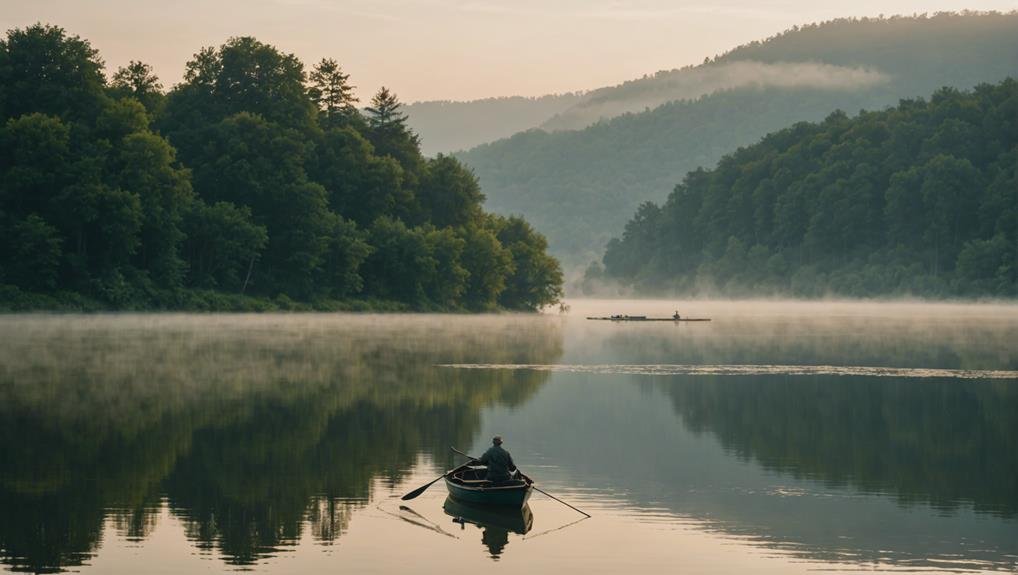You’ve probably heard that bass fishing is as much an art as a sport. With the right techniques and timing, you can greatly enhance your fishing adventures. Consider the thrill of engaging with nature and the strategic challenge of outsmarting a bass using just your rod, reel, and wits. Now, imagine there’s a specific time frame when bass are more active and likely to bite—wouldn’t you want to know when that is? Stay tuned, and I’ll share insights that could transform your approach and catch rate. Are you ready to up your game?
Key Takeaways
- Utilize medium-heavy rods with fast action tips and baitcasting reels for effective bass fishing.
- Choose line type based on water clarity; fluorocarbon for clear and braided for heavy cover.
- Employ specific techniques like Spinnerbait in murky waters and Texas Rig for weedless presentations.
- Best fishing times are at sunrise, sunset, and night during warmer months, especially in spring and early summer.
- For successful bass fishing, target areas with ample structure, such as rocky shorelines, submerged vegetation, and deep drop-offs.
Essential Bass Fishing Gear
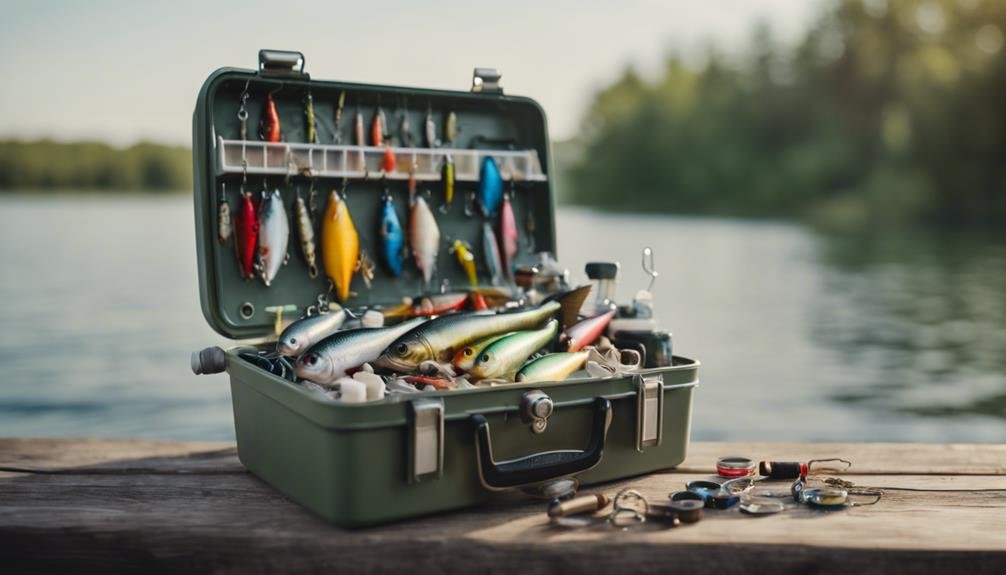
To maximize your success in bass fishing, you must equip yourself with the right gear, including medium-heavy rods with fast action tips and baitcasting reels. These tools enhance your control and responsiveness, letting you feel the slightest nibble of a bass. When choosing your fishing line, consider the water clarity. Fluorocarbon lines are great in clear waters due to their invisibility and sensitivity, helping you sneak up on wary bass. Braided lines are better in areas with heavy cover as they offer the strength needed to pull bass out of their hiding spots.
Lure selection is vital and should adapt to water conditions. Opt for shad or silver lures in clear water to mimic natural fish colors. Stained waters call for brighter options like chartreuse or red to stand out. Go with black or blue in muddy settings to create a visible silhouette. Don’t forget about maintaining your equipment. Regularly clean and oil your reels, check your rods for damage and replace old lines. This maintenance keeps your gear in top shape, increasing your chances of a successful catch. Remember, the right fishing lures and well-maintained gear are your best allies in mastering bass fishing.
Top Bass Fishing Techniques
Mastering effective bass fishing techniques can greatly enhance your catch rate. Let’s explore some top methods to keep your line tight and adrenaline-pumping.
| Technique | Description | Ideal Condition |
|---|---|---|
| Spinnerbait | It uses flashy blades to attract bass in murky waters or overcast days. | Best in windy, cloudy conditions |
| Texas Rig | A versatile setup using a plastic worm or creature bait that’s great for weedless presentations. | Effective in heavy cover |
| Ned Rig | A minimalist approach with a small, soft plastic on a light jig head, perfect for finicky fish. | Clearwater, slow bite days |
| Shaky Head | A jig head with a worm rigged straight stands upright on the bottom, mimicking natural prey. | When bass are less active |
| Plastic Worm | It can be rigged in various ways, but it excels in Texas Rig for sneaking into tight spots. | All-around versatile |
You’ll find each technique has its unique flair. The Texas rig, for instance, lets you work your bait through thick cover where bass hide. Using a spinnerbait, you’re likely to lure out bass with its vibrant flashes, especially effective in stained waters. So, grab your gear, pick your technique, and get ready to impress with your skills at the lake!
Best Times for Bass Fishing
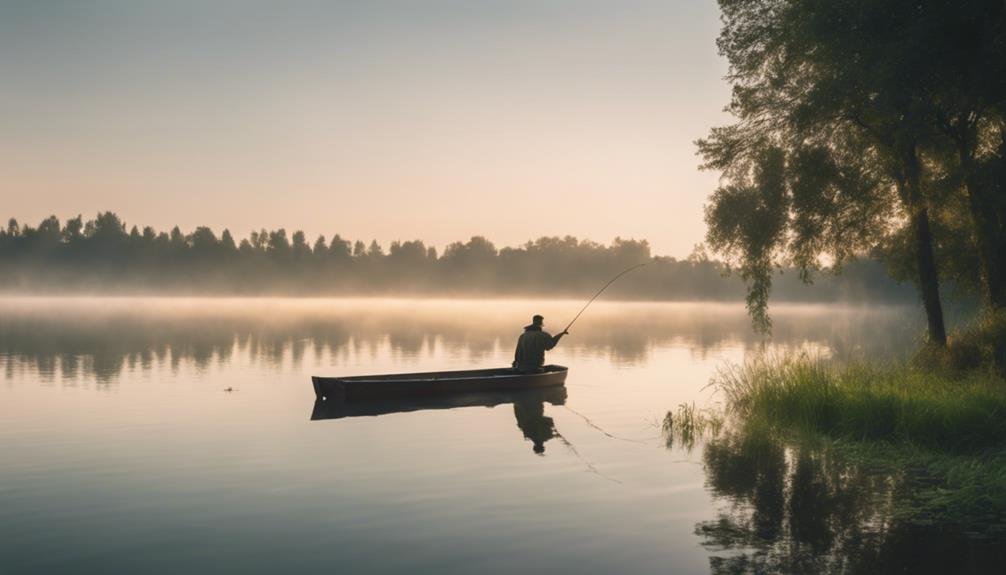
You’ll find that the best times for bass fishing are during the cooler, low-light periods of sunrise and sunset. These times offer a magical window when bass are most active, making them ideal for casting your line. Especially in the warmer months, consider extending your fishing into the night. It’s not just about comfort from the heat, but the bass is naturally more active than searching for food without the direct overhead sun.
Peak times for bass fishing occur in spring and early summer. During these seasons, water temperatures are typically between 60-75 degrees Fahrenheit, the perfect range for bass to be highly active. They’re busy feeding and spawning, so they’ll be on the move, giving you more opportunities to land a catch.
Bass relate strongly to cover, so when you’re out during these prime times, pay close attention to places like stumps, timber, and grass beds. These spots can be goldmines because bass use them for protection and hunting. Targeting these areas during the best times increases your chances significantly, as bass are likelier to venture out from their hideouts to feed.
Ideal Bass Fishing Locations
Ideal bass fishing locations span diverse environments like ponds, lakes, rivers, and reservoirs, each offering unique structures and covers that attract bass. As you scout for prime spots, focus on areas with ample structure and hiding spots, which are important for ambushing prey. Rocky shorelines provide nooks where bass can lurk undetected, while submerged vegetation offers a rich habitat for smaller organisms and a perfect ambush cover for bass.
Deep drop-offs are another hotspot, where bass often congregate to take advantage of varying prey availability at different depths. Don’t overlook boundary areas either—spots where depth changes dramatically or different types of cover meet. These areas are particularly appealing to bass as they provide opportunities to explore different feeding grounds near each other.
Understanding the habitat preferences of the specific bass species you’re targeting is essential. Largemouth bass prefer warmer, shallower waters with abundant cover like grass beds or logs, whereas smallmouth bass are more often found near rocky outcrops in clearer waters. Spotted bass, on the other hand, might lead you to areas with moderate currents and clearer water. Tailoring your location choice to the species can greatly increase your success.
Effective Bass Lures
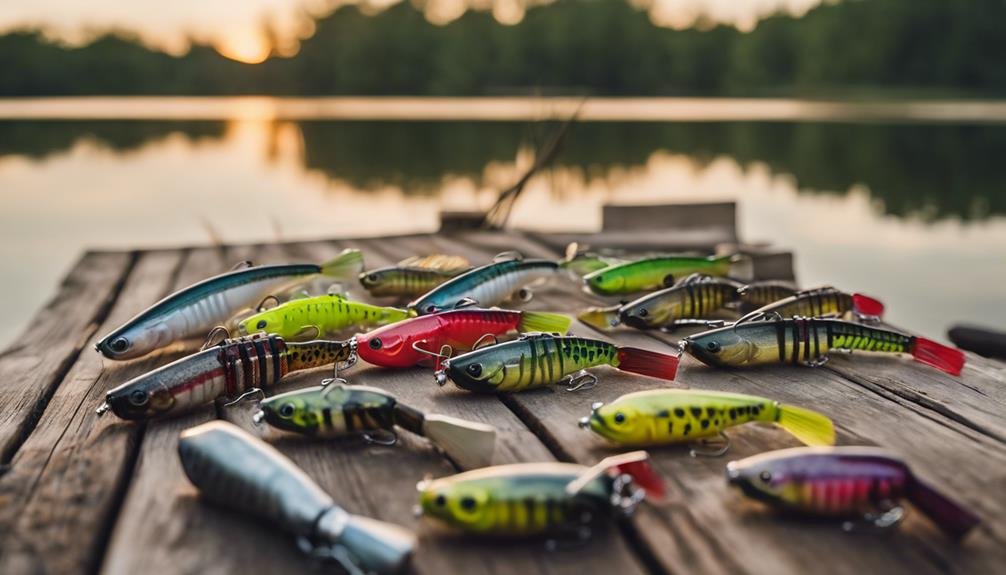
Choosing the right bass lure can greatly enhance your fishing success, as different designs and actions attract bass under varying conditions. Here’s a quick guide to some effective bass lures you should consider:
- Spinnerbaits: These lures are fantastic for varying water conditions. Opt for spinnerbaits with gold blades to increase your chances, as they’re particularly effective in attracting bass with their vibrant flash and vibration.
- Soft Plastic Frogs: When targeting bass in topwater scenarios, soft plastic frogs are your go-to. They mimic real frogs perfectly, making them irresistible to bass lurking beneath vegetation or lily pads.
- Ned Rigs: Ideal for clear water, Ned Rigs with compact plastic baits excel by imitating small prey fish. This subtle approach can be key when dealing with wary fish.
- Shaky Heads: Pair these with finesse worms for a subdued presentation. They’re especially useful for pressured bass, allowing a slower, more enticing action that often triggers bites from cautious fish.
Additionally, don’t forget about Drop Shot Worms for deeper water. Their vertical presentation can be a game-changer, enticing bass that is suspended or holding tight to structure. So next time you’re out on the water, make sure you’ve got these lures ready.
Understanding Bass Behavior
Understanding how bass behavior changes with factors like water temperature and available cover is crucial to effectively targeting them. When you’re fishing, remember that bass activity is closely linked to water temperature. Largemouth bass, for instance, are most active and feed more aggressively when the water is between 60 and 75 degrees Fahrenheit. This knowledge can greatly impact your success.
Bass also respond to changes in their habitat, seeking out areas with ample cover to hide and ambush prey. You’ll often find them around stumps, timber, grass beds, and docks. These spots provide safety from predators and excellent opportunities to catch unsuspecting food. Food availability greatly influences where and how bass decides to spend their time. Areas rich in food sources are hotspots for bass, especially during feeding times.
Additionally, tuning into bass spawn cycles can give you an edge. In spring, when water temperatures rise above 65 degrees, bass start their spawn, making them more predictable and concentrated in specific areas. During this period, they’re also more aggressive, defending their nests, which can be an ideal time for you to strike.
Bass Fishing Boat Essentials
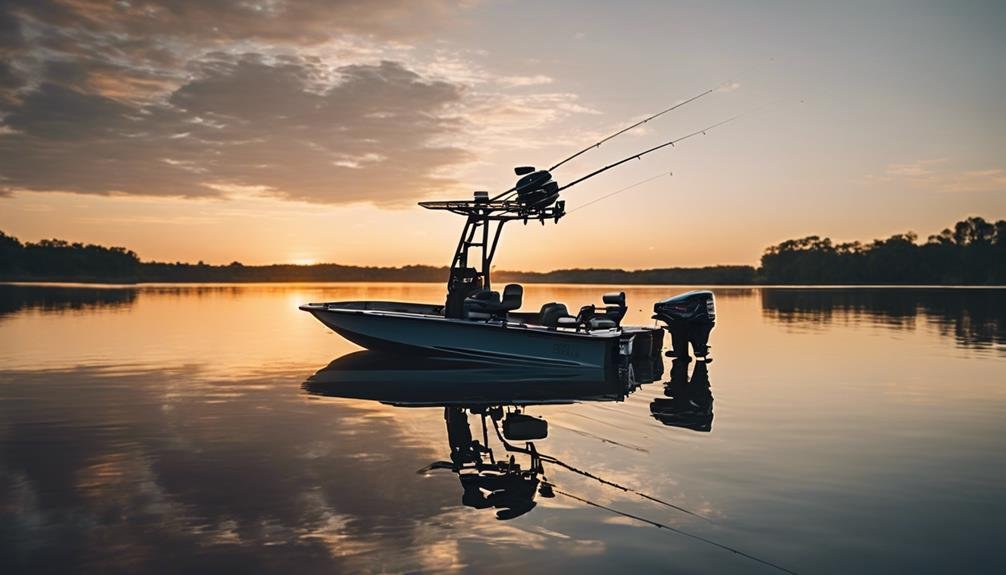
While selecting the right bass fishing boat, consider each type’s specific advantages for the waters you plan to explore. You’ll find that Jon Boats, Bass Boats, Fishing Kayaks, and Canoes each bring unique benefits that can enhance your fishing experience.
Here’s a quick breakdown to help you decide:
- Jon Boats: Ideal for bass anglers looking for versatility and affordability, Jon Boats provides a stable, easily customizable platform. They’re great for both calm lakes and somewhat rougher waters.
- Bass Boats: If speed and efficiency are your priorities, a Bass Boat is your best bet. These are equipped with powerful engines designed for peak performance, including ample storage for all your gear—perfect for competitive fishing.
- Kayaks: Fishing Kayaks are the way for those who want to sneak up on bass in shallow or hard-to-reach areas stealthily. They offer a quiet approach, minimizing water disturbance and allowing closer proximity to fish hideouts.
- Canoes: When aiming for a peaceful day in calm waters, canoes are excellent. They allow for silent travel and can accommodate extra gear for a longer day of fishing.
Choose wisely based on where you’ll fish most often and what your fishing style entails.
Catching Your First Bass
Starting out on your bass fishing adventure, you’ll want to target bass in sheltered, shallow waters with abundant cover and structure. These areas provide great hiding spots for bass, making them more likely to bite. You’ll find that using natural bait like minnows can be highly effective. Bass can’t resist the allure of live prey wiggling through the water.
However, don’t overlook the power of artificial lures. Crankbaits and soft plastics mimic the movement of bass prey and can be just as enticing. It’s all about how you present these lures. Focus on your casting accuracy. Being able to place your lure exactly where you want it, near logs, rocks, or vegetation, greatly increases your chances of a strike.
Patience is your best friend here; bass aren’t always ready to bite. You might need to experiment with different retrieval speeds and depths. Sometimes a slower, more deliberate retrieve works better, especially if the bass are finicky. Keep at it, adjust your techniques as needed, and remember, each cast brings you closer to landing your first bass. Stick with it, and you’ll soon experience the thrill of your first catch.
Advanced Bass Fishing Tips

As you progress in bass fishing, mastering advanced techniques like flipping and pitching becomes essential for targeting bass in dense cover. These methods allow for precise lure presentation, which is critical when maneuvering through thick vegetation or submerged structures where bass hide.
To enhance your skills, consider these strategic approaches:
- Understand Bass Behavior: Bass react differently depending on the season. During pre-spawn, they’re aggressive, making it a perfect time for active lures. In contrast, the post-spawn period may require more finesse as bass are recuperating.
- Fine-Tune Your Lure Presentation: Adjusting your retrieve’s speed, depth, and cadence can make a significant difference. Slow your approach in colder water and speed it up when it warms.
- Utilize Advanced Electronics: Fishfinders and GPS units help you locate key underwater structures and schools of baitfish. This technology is invaluable for efficient targeting and reducing time spent in unproductive waters.
- Experiment with Advanced Rigs: Techniques like the Tokyo or Punch Rig can offer unique advantages in specific situations, particularly in heavy cover or deeper waters.
Conclusion
Now, you’re equipped with the essentials to master bass fishing. Whether you’re gearing up with the right rod and reel or exploring the best lures and techniques, remember that timing and location are key.
Understand bass behavior to enhance your strategy, and don’t forget your boat essentials. Whether it’s your first catch or you’re fine-tuning your skills, bass fishing is always an exciting challenge.
So, grab your gear, hit those prime spots, and enjoy the thrill of the catch!
FAQs
What gear do I need for bass fishing?
Gear up with a medium-heavy rod, fast action tip, and baitcasting reel. Choose fluorocarbon for clear waters, braided for heavy cover. Select lures based on water clarity.
What are the best techniques for bass fishing?
Utilize spinnerbaits in murky waters, Texas rig for weedless presentations, and Ned rig in clear water. Adjust techniques based on conditions for optimal results.
When is the best time to go bass fishing?
Sunrise, sunset, and night are prime times for bass, especially in warmer months. Bass are most active in spring and early summer when water temperatures are between 60-75°F.
